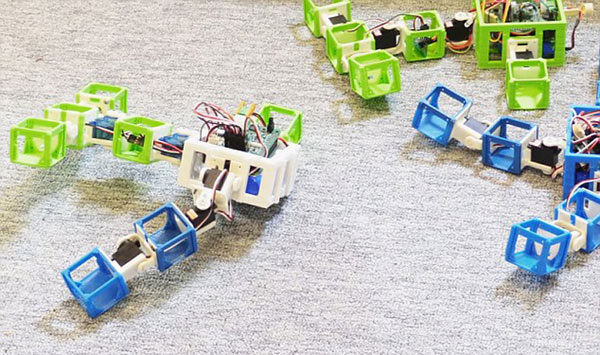當(dāng)前位置: Language Tips> 雙語新聞
Now robots can have KIDS: Researchers create machines that 'mate' over wifi to create a 3D printed baby - and experts say they could be used to colonise Mars
分享到
 |
| 圖中右側(cè)就是機(jī)器人父母,左側(cè)則是機(jī)器人寶寶。圖中可以看到,機(jī)器人父母分別是藍(lán)色和綠色的,機(jī)器人寶寶身上藍(lán)、綠色都有。 |
What if robots could evolve?
如果機(jī)器人可以自主進(jìn)化的話,那么這將會是一幅怎樣的場景呢?
It's the question asked by a group of scientists in Amsterdam, whose radical new project aims to create smarter, more advanced robots through a process similar to sexual reproduction.
這一問題由阿姆斯特丹的科學(xué)家們提出,他們創(chuàng)立一項不同凡響的新項目,旨在通過類似有性生殖的過程創(chuàng)造出更智能、更先進(jìn)的機(jī)器人。
While the idea may sound far-fetched, they've already demonstrated a proof of concept – in February, two robot parents came together to 'mate,' and the first 'robot baby' was born.
雖然這一想法聽起來有些難以置信,但是他們卻已證明其確實可行:二月,一對機(jī)器人父母通過“交配”,生下了首個“機(jī)器人寶寶”。
In the Robot Baby Project at Vrije Universiteit Amsterdam, scientists have developed a way for robots to have 'sex' and pass on their DNA to offspring.
在阿姆斯特丹自由大學(xué)的“機(jī)器人嬰兒項目”中,科學(xué)家已經(jīng)研發(fā)出一種使機(jī)器人通過“性交”而將DNA傳遞給后代的辦法。
Doing this can allow them to 'develop their bodies through evolution,' making for successive generations that have more advanced physical and behavioural capabilities.
這一做法可使機(jī)器人實現(xiàn)自我進(jìn)化發(fā)展,從而使其后代能擁有更高級先進(jìn)的身體機(jī)能和行為能力。
As the process continues, the researchers say robots can become more suitable for use in unknown environments that could be hazardous to humans, like deep sea mines or even other planets.
隨著研究推進(jìn),研究人員認(rèn)為這些機(jī)器人更適合用在對人類有害的未知領(lǐng)域中,比如深海礦井甚至是其它星球。
'We have two robots that meet and mate, and just as in the animal kingdom, this results in a baby,' says Guszti Eiben, Professor of Artificial Intelligence at VU, in a video explaining the concept.
阿姆斯特丹自由大學(xué)的人工智能教授Guszti Eiben在一段視頻中對這一概念解釋道:“就像在動物界里一樣,兩個機(jī)器人相見交配,然后就有了寶寶。”
The robots live, work, and reproduce in an 'Arena,' where they are able to select a suitable mating partner.
這些機(jī)器人在實驗室的“人生舞臺”上生活、工作和繁殖,在那里它們可以選擇適合交配的另一半。
When the two robots come together, they are then able to communicate and even mate.
當(dāng)兩個機(jī)器人邂逅相遇,它們可以相互交流甚至交配。
'When they evaluate each other favourably, they send their genomes through the Wi-Fi network,' says Milan Jelisavcic, a PhD student at the university.
該大學(xué)的博士生Milan Jelisavcic說:“當(dāng)它們評估對方為積極良性時,會通過Wi-Fi發(fā)送各自的基因組。”
'A sexual reproduction mechanism then creates the new genome. Code of this genome is sent to the 3D printer then, for printing new components.'
“這種有性繁殖機(jī)制能創(chuàng)造出新的基因組,然后這一基因組代碼會被發(fā)送至3D打印機(jī)上,進(jìn)而打印出機(jī)器人寶寶的組成部件。”
During a year-and-a-half development period, the researchers were able to achieve the implementation of a full life cycle.
在一年半的研發(fā)進(jìn)程中,研究人員實現(xiàn)了一個完整的生命周期測試。
When the parent robots 'reproduce,' their features are randomly recombined.
當(dāng)機(jī)器人父母“繁衍后代”時,他們的特征是隨意組合的。
This includes the brain – software – and the hardware.
這其中包括大腦(軟件)和硬件。
'With evolutionary techniques, we evolve the neural networks of the robots,' explains Jacqueline Heinerman, PhD student at VU, in the video.
視頻中,學(xué)校里的另一個博士生杰奎琳?海納曼解釋道:“隨著技術(shù)發(fā)展,我們能夠開發(fā)機(jī)器人的神經(jīng)網(wǎng)絡(luò)。”
These neural networks are responsible for their behaviours.
這些神經(jīng)網(wǎng)絡(luò)主控機(jī)器人的行為。
The lab also contains a 'Birth Clinic' and a 'Nursery' for the robotic child, and once born, each must undergo a learning process.
研究實驗室中還為機(jī)器人寶寶設(shè)立了“產(chǎn)房”和“育兒室”,出生后,每個機(jī)器人寶寶都必須進(jìn)行學(xué)習(xí)。
If it is deemed satisfactory, the child then becomes an adult, and potentially, a parent.
一旦它們符合條件要求,便可步入成人階段,還有可能為生育下一代做準(zhǔn)備。
Researchers say this marks the start of a new era – the Industrial Evolution.
研究人員認(rèn)為,這標(biāo)志著“工業(yè)進(jìn)化”新時代的開始。
In this state, machines could autonomously operate and reproduce.
依此看來,機(jī)器人可以自主操作與繁殖。
One day, they say, this new form of evolution could even play a critical role in the colonization of Mars.
他們表示,終有一天,這一全新的進(jìn)化方式將在殖民火星的過程中扮演舉足輕重的作用。
Vocabulary
genomes:基因組
neural networks:神經(jīng)網(wǎng)絡(luò)
英文來源:每日郵報
翻譯:章琳(中國日報網(wǎng)愛新聞iNews譯者)
編審:yaning
上一篇 : 穿高跟鞋不傷腳的六個技巧
下一篇 : 信不信:無聊大會受熱捧
分享到
關(guān)注和訂閱


翻譯
關(guān)于我們 | 聯(lián)系方式 | 招聘信息
電話:8610-84883645
傳真:8610-84883500
Email: languagetips@chinadaily.com.cn